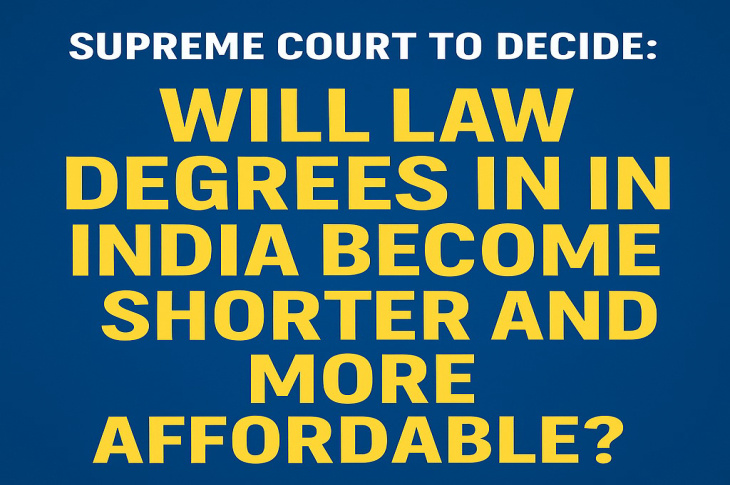Supreme Court to Decide: Will Law Degrees in India Become Shorter and More Affordable?
Introduction: The Legal Education Debate Reaches the Supreme Court
Legal education in India is at a turning point. On September 9, 2025, the Supreme Court of India is set to hear a significant Public Interest Litigation (PIL) that questions the duration, affordability, and overall structure of legal degree programmes like the five-year integrated LL.B and two-year LL.M courses.
The PIL, filed by Advocate Ashwini Kumar Upadhyay, calls for transformative changes, including the creation of a Legal Education Commission. The petition has sparked a national debate: Should law degrees be shortened? Can legal education be made more accessible and affordable to aspiring lawyers across India?
Let’s explore this in detail — from the contents of the PIL to its legal implications, the role of regulators like the BCI and UGC, and the potential impact on students, law colleges, and the legal profession.
Also Read: How to Become a Lawyer in India: A Comprehensive Guide
What Triggered This PIL?
The PIL was filed in the Supreme Court by Ashwini Kumar Upadhyay, a practicing lawyer and public interest advocate known for filing socially relevant cases. In his petition titled “Ashwini Kumar Upadhyay v. Union of India & Ors”, he raised several pressing concerns:
-
The five-year integrated LL.B programme is excessively long and financially burdensome.
-
The two-year LL.M programme adds further delay and cost for students.
-
The current system does not align with the National Education Policy (NEP) 2020, which recommends a four-year multidisciplinary undergraduate programme.
-
Legal education lacks a dedicated regulatory commission, unlike medicine or engineering.
-
Many private colleges and even National Law Universities (NLUs) charge exorbitant fees, making legal education inaccessible for students from economically weaker backgrounds.
Supreme Court’s Response: Who Has Been Notified?
On July 2025, a bench comprising Justice Surya Kant and Justice Joymalya Bagchi issued notices to:
-
Central Government
-
Bar Council of India (BCI)
-
University Grants Commission (UGC)
-
Law Commission of India
All these bodies have been asked to file their responses before the next hearing on September 9, 2025. The matter now lies before the highest constitutional court in the country.
Also Read: Top Ten Criminal Lawyers In India
Key Demands in the PIL
Here’s a simplified breakdown of what the PIL demands:
Formation of a Legal Education Commission
-
A regulatory body consisting of jurists, retired judges, senior advocates, and legal scholars.
-
Purpose: To study and recommend reforms to the structure, duration, pedagogy, and accessibility of law degrees.
Shortening of the Law Degree Duration
-
Revise the five-year LL.B and two-year LL.M courses to align with NEP 2020 standards.
-
Possibility of a four-year integrated LL.B, or three-year undergraduate + one-year LL.B. model.
Affordability and Access
-
Make legal education more affordable by regulating fee structures, especially in private institutions.
-
Provide scholarships and education loans with lower interest rates for law students.
Early Entry into Legal Practice
-
Encourage early entry into the profession by reducing academic delays.
-
Cites examples of legends like:
-
Ram Jethmalani, who began practice at 17
-
Fali Nariman, who earned his law degree by age 21
-
Dedicated Regulatory Authority
-
Proposes a Law Education Commission similar to:
-
National Medical Commission (NMC) for medical education
-
All India Council for Technical Education (AICTE) for engineering and technology
-
Legal Education in India: Current System
Five-Year Integrated LL.B
-
Introduced in 1987 through the National Law School of India University Act.
-
Combines a Bachelor’s degree (B.A., B.Com, B.Sc) with LL.B.
-
Popular among students post-12th grade.
Three-Year LL.B
-
For students who already hold an undergraduate degree.
-
Still offered by many public and private universities.
Two-Year LL.M
-
Postgraduate legal education.
-
Focuses on research and specialization (e.g., corporate law, criminal law, constitutional law).
Fee Structures
-
NLUs charge between ₹2 lakh to ₹3.5 lakh per year.
-
Private colleges may charge even more.
-
Law education can easily cost over ₹10–15 lakhs, making it unaffordable for many.
Why Advocate Ashwini Upadhyay Thinks It’s a Problem
1. High Costs = Limited Access
-
Students from low-income families often cannot afford law school.
-
Many give up the dream due to tuition fees, hostel expenses, and exam costs.
2. Lengthy Education = Delayed Career Start
-
A five-year law degree followed by two years of LL.M can delay earning opportunities until age 25 or later.
3. Mismatch with NEP 2020
-
NEP encourages flexibility, multidisciplinary learning, and early employability.
-
Law education, the PIL argues, hasn’t kept up with these reforms.
4. Regulatory Gaps
-
No single authority governs legal education.
-
BCI focuses on professional licensing, while UGC governs university curriculum.
-
Result: No unified policy, overlapping jurisdictions, and inconsistent quality standards.
What Does the National Education Policy 2020 Say?
The NEP 2020, launched by the Ministry of Education, recommends:
-
Four-year undergraduate degrees
-
Multidisciplinary curricula
-
Multiple exit options
-
Entry-level employment readiness
The PIL argues that law education has failed to adapt to these recommendations. By retaining rigid formats, it continues to be inaccessible and outdated.
Legal Giants Who Benefited from Early Start
The petition makes a compelling emotional and historical argument by pointing out how great Indian jurists started early in life:
| Name | Age at Starting Law Career | Notable Achievement |
|---|---|---|
| Ram Jethmalani | 17 | One of India’s top criminal lawyers |
| Fali Nariman | 21 | Senior Advocate, Former Solicitor General |
| Soli Sorabjee | 22 | Former Attorney General |
| Nani Palkhivala | 23 | Constitutional expert and economist |
These examples highlight that longer degrees are not necessarily better, and early engagement with the legal field can lead to outstanding contributions.
Arguments Against the Current Legal Education Structure
The PIL raises several systemic problems:
-
Commercialisation of legal education, especially by private colleges
-
Inadequate infrastructure and faculty in many law schools
-
Outdated curriculum, not aligned with modern legal needs like tech law, AI, IP, and cybercrime
-
Rigid examination systems, which don’t assess practical legal skills
-
Insufficient internship opportunities, particularly in tier-2 and tier-3 cities
What Could Change If the PIL Succeeds?
If the Supreme Court agrees with the PIL and asks for restructuring, several positive outcomes may follow:
1. Shorter, Flexible Law Degrees
-
Introduce four-year LL.B aligned with NEP.
-
Allow credit transfers, lateral entries, and exit points.
2. Affordable Education
-
Cap tuition fees at public institutions.
-
Scholarships and education loans for students from marginalised communities.
3. Skill-Oriented Learning
-
Emphasis on clinical legal education, moot courts, legal aid work.
-
Integration of legal tech, ethics, and policy making in the curriculum.
4. Unified Regulation
-
Set up a Law Education Commission to:
-
Design curriculum standards
-
Accredit law schools
-
Conduct national legal education audits
-
5. Early Professional Start
-
Reduce unnecessary academic delays.
-
Let students join litigation or corporate law earlier.
Concerns from the Legal Education Community
While reform sounds promising, several experts have expressed caution:
1. Risk of Diluting Quality
-
Shorter degrees may compromise on legal depth and rigor.
2. Regulatory Overlap
-
Adding another regulator could increase bureaucracy, unless powers are clearly defined.
3. One Size Doesn’t Fit All
-
India’s legal education needs regional flexibility, not just top-down reforms.
4. Implementation Delays
-
Even if reforms are approved, rollout across 1500+ law colleges may take years.
What Do Law Students Think?
Many law students have welcomed the PIL, especially those from rural or middle-class backgrounds. Here’s what some of them had to say:
-
“If fees are regulated and law degrees made shorter, I can start supporting my family sooner.”
-
“We want practice-based learning, not just theory-heavy semesters.”
-
“Why is legal education so expensive when the aim is to uphold justice and equality?”
These voices are a powerful reminder of why education reforms should be people-centric.
International Comparison: How Long Is Law School Elsewhere?
| Country | Duration of Law Degree | Comments |
|---|---|---|
| United States | 3 years (after any UG degree) | J.D. is postgraduate |
| United Kingdom | 3 years + 1-year LPC | Modular and skill-based |
| Australia | 5 years integrated / 3 years | Similar to India |
| Germany | 4-5 years | Includes state exams and practicals |
| Singapore | 4 years | NEP-aligned model |
The petition uses these comparisons to argue that India’s structure is needlessly long and expensive.
What Happens on September 9, 2025?
On this date, the Supreme Court will review responses from the Centre, BCI, UGC, and others. The judges will consider:
-
Whether the current model violates the Right to Equality and Right to Education
-
Whether there's a need for a Law Education Commission
-
Whether legal education should align with NEP 2020
The judgment could become a turning point for legal education in India.
Conclusion: Legal Reform or Missed Opportunity?
This PIL presents a historic opportunity to democratise legal education. By reducing course duration, regulating fees, and improving quality, the legal profession could become more inclusive, future-ready, and socially impactful.
Whether the Supreme Court pushes for a Legal Education Commission or recommends changes through existing bodies, one thing is clear — legal education in India cannot remain frozen in time.
It must evolve with the needs of the society it serves.
Frequently asked questions
What is the current duration of LL.B and LL.M in India?
What is the current duration of LL.B and LL.M in India?
LL.B: 5 years (integrated) or 3 years (after UG); LL.M: 2 years.
Will NLUs and private colleges reduce their fees if reforms pass?
Will NLUs and private colleges reduce their fees if reforms pass?
If the Supreme Court issues directives, regulatory fee capping may follow.
Why is there a demand to shorten the law degrees?
Why is there a demand to shorten the law degrees?
To reduce costs, align with NEP 2020, and enable early career entry.
What is the Legal Education Commission proposed in the PIL?
What is the Legal Education Commission proposed in the PIL?
A regulatory body of legal experts to restructure law education.
What’s the next hearing date for this PIL?
What’s the next hearing date for this PIL?
The matter is listed for September 9, 2025 in the Supreme Court.
Trending
Frequently asked questions
What is the current duration of LL.B and LL.M in India?
What is the current duration of LL.B and LL.M in India?
LL.B: 5 years (integrated) or 3 years (after UG); LL.M: 2 years.
Will NLUs and private colleges reduce their fees if reforms pass?
Will NLUs and private colleges reduce their fees if reforms pass?
If the Supreme Court issues directives, regulatory fee capping may follow.
Why is there a demand to shorten the law degrees?
Why is there a demand to shorten the law degrees?
To reduce costs, align with NEP 2020, and enable early career entry.
What is the Legal Education Commission proposed in the PIL?
What is the Legal Education Commission proposed in the PIL?
A regulatory body of legal experts to restructure law education.
What’s the next hearing date for this PIL?
What’s the next hearing date for this PIL?
The matter is listed for September 9, 2025 in the Supreme Court.



Ask a Lawyer